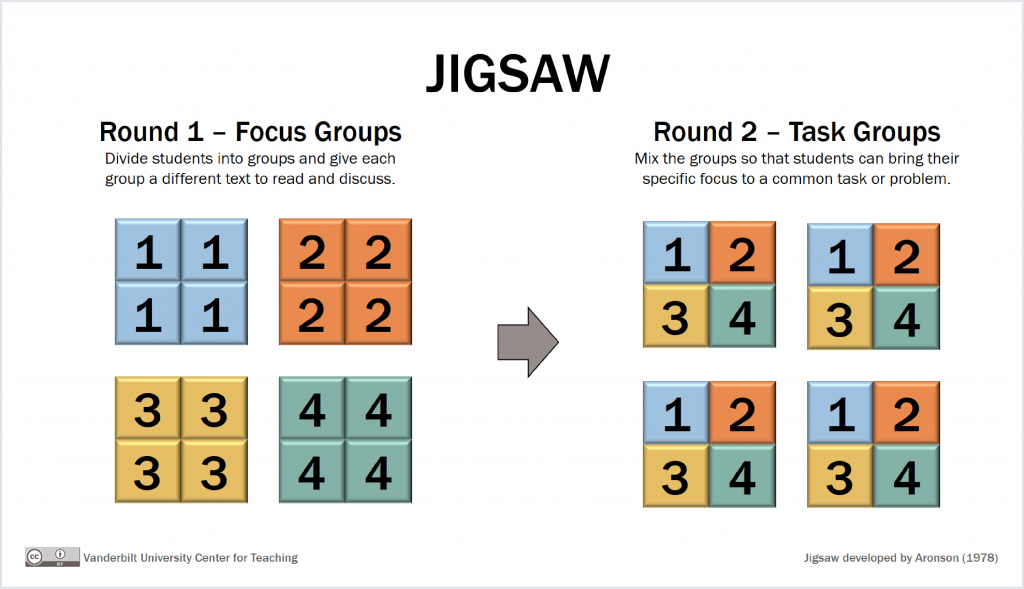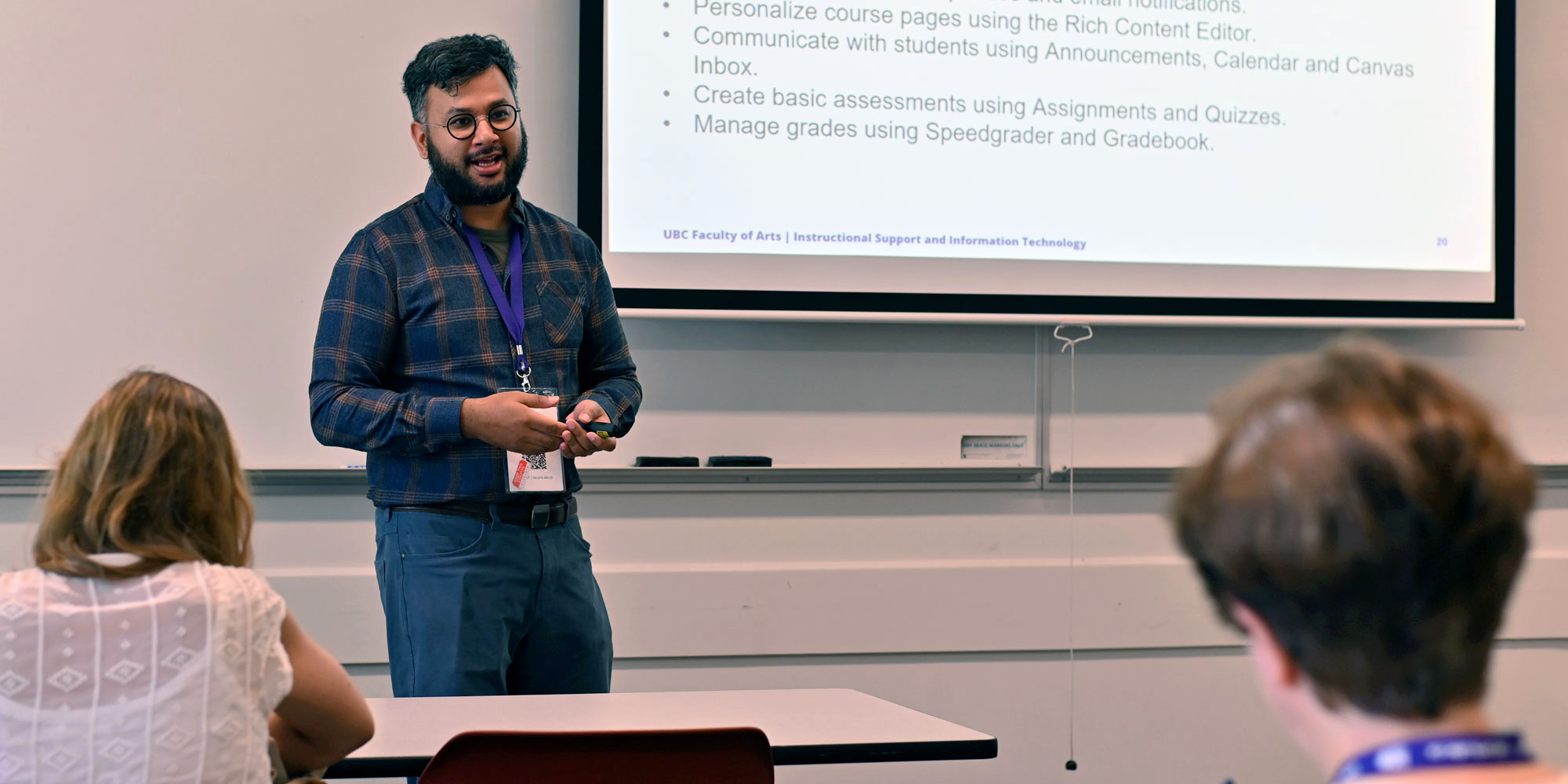

Incorporating active participation techniques and the assessment components that go with them help to broaden the students’ practice and competencies and provides a richer experience for instructors for grading and providing feedback.
–Allen Sens, Professor of Teaching (POLI)
Description
This is a collection of smaller recipes that can be used to encourage active learning and student participation. They were developed in the context of larger lecture courses, but could be applicable in many different contexts. The recipes range in scale and complexity from simple activities that can be implemented in one class session, to course or module length group exercises that require more significant planning and course redesign.
Goals
One of the key motivations for developing these activities was to give students more opportunities to learn by doing and provide them the opportunity to apply what they were learning in class through problem solving and teamwork. Another goal was to add more diverse modes of instruction and create more diverse assessment methods beyond the exam and paper model. Incorporating active participation techniques and the assessment components that go with them helps to broaden the students’ practice and competencies and provides a richer experience for instructors for grading and providing feedback.
Objectives
- To incorporate student-centered activities in synchronous and asynchronous learning environments;
- To enhance student engagement, active learning, problem-solving, and teamwork capacities;
- Apply higher-order Bloom’s taxonomy learning outcomes (evaluation, application, synthesis);
- To offer a wider diversity of assignments (projects, worksheets) and mixed modes of instruction (lecture, activity, group work)
Level of Difficulty: Easy to Medium
Course: POLI 377
Number of Students: Large Lectures
Time: 1 class to full course length
Delivery: Sync and async
Yield: Active student participation
Keywords: Collaborative group work, student-centered learning, active learning pedagogy, case-studies, role play, peer evaluation
Teaching Recipes
Recipe 1 | Shake and Bake (Breakout)
Description
Shake and Bake is the most basic of the recipes in this collection. It involves a short, easy to set up collaborative group activity that typically occurs within a single class session and is meant to give students the opportunity to apply and reflect on the concept being covered that day. Grading is low stakes and can be used as an attendance or participation grade for the day.
Delivery: Synchronous
Prep Work
- Instructor decides to either pre-assign students to a group or have students self-select into a group.
- Instructor creates group project activity along with associated worksheets and requirements or grading rubric. Note: This activity will be completed in one class session.
Method
Class time will be divided into three parts.
- The first part of class will consist of lecture and setting students up for the learning activity. The learning activity can be in the form of a worksheet, short reflection assignment, etc.
- During the second part of lecture, students will transition into their breakout groups to complete a short project/assignment.
- Finally, for the remainder of the class time, the instructor will gather students back into the larger group and wrap up the activity by engaging students in discussion and reflection along with observations and conclusions from the instructor.
The suggested timing for each part of lecture are as follows: 25%, 50%, 25%. Grading A small portion of the grade will be assigned for participation and accuracy of completion in in-class activities. Students can either submit a worksheet in class (for in person classes) or submit their activity online.
Recipe 2 | Flipped Over Easy (Flip a Class)
Description
This activity involves flipping a single class session, so it requires a little more preparation to develop the online components ahead of the class. It provides a good entry into experimenting with flipped pedagogy without the investment of flipping an entire course. Generally, students will work independently through a set of learning materials online, usually readings and instructional videos, before coming to class. It is important to make sure all of the students complete the online material ahead of class so having some type of pre-class or pre-learning assessment is necessary. During the class, students spend the majority of the session completing a small group project or activity based on those materials. Activities such as role plays or case studies work well. Delivery Asynchronous and synchronous Prep Work
- Develop the online lesson (readings, instructional videos)
- Develop the pre-class or pre-learning assessment. This can be a quiz, a reflection activity or other short assignment that needs to be completed before coming to class (or is handed in at the beginning of class).
- Create student groups, the in-class group activity, and assessment rubrics. Note: This activity is completed in a single class session, but has a required online component that needs to be completed by students prior to coming to class.
Method
To facilitate student-centered learning, the instructor will flip the class by dividing class time up into two blocks of time.
- In the first part of session, students will spend the majority of time working on a small group activity/project with their group members. At the end of the first part, students will be expected to submit their group project.
- In the second part of lecture, students will spend the remainder of class making observations, discussing, and drawing conclusions from their in-class group activity.
The suggested timing for each part of lecture are as follows: 80%, 20%.
Grading
A small portion of the overall course grade will be assigned for both the accuracy and the completion of pre-learning assignments/assessments and the group project that is submitted. A rubric that establishes clear expectations and criteria for grading is important for grading the group project.
Recipe 3 | Scrambled Eggs (Jigsaw)
Description
This activity is can be used effectively to help students understand an issue from a diverse range of perspectives. It requires students to learn about a particular point of view and then discuss an issue or scenario from that point of view with others who have been assigned a different perspective. It is a fully student-centered learning activity that involves active participation from all group members.
This activity typically spans two full class sessions and requires a little bit more planning and time commitment than the previous two recipes in this collection. Outcomes include submission of two unique group projects, one at the end of the first session and another by the end of the second session. The figure below illustrates how to setup a jigsaw learning activity (left: first class; right: second class).


Jigsaw developed by Aronson (1978)
Delivery
Asynchronous and/or synchronous
Prep Work
- Pre-set groups (between six to eight students) and decide on the delivery mode (in class or online). The activity could consist of two synchronous sessions, two asynchronous sessions, or one synchronous and one asynchronous session. The instructor develops topics for the group sessions and pre-assigns groups to topics.
- Create instructions for students to conduct research on their assigned topics prior to the start of the first class or develop pre-selected materials for them to read or view.
- Develop pre-class or pre-learning assessments (such as a short assignment or quiz). Note: This activity will be completed over two back-to-back class sessions (or one if you have a 3 hour class block).
Method
- Prior to the first class session students are placed into pre-set groups of 6-8. Each group is assigned a shared identity, purpose or perspective. Before coming to class, students are provided with pre-learning materials that include either instructions for researching their assigned topic or a set of pre-selected readings and/or videos that help them learn about the topic. Students then complete a pre-learning assignment or quiz for submission before the start of class.
- During the first class, students who are working on the same topics will meet together in one group to report, discuss, and share relevant findings from their research. By the end of the first class, they should be experts on their topic and be comfortable to share the information with new group members in the second class. Students complete and submit a small group project based on their topic.
- In session two, the instructor forms new groups that consist of one student from each of the previous groups from session 1. During the second class, students meet in these newly formed (“scrambled”) groups to teach and facilitate a discussion or engage in a on their research topic. Each person will have the opportunity to present their research topic and the expected outcome is for each person in the group to learn a new topic. By the end of second class, students will submit their project.
- A concluding segment for reflection can be added to either the following or done asynchronously online. While it could be done in the second class, it hasn’t been done in this example in order to maximize student time in their groups.
Grading
A small grade is assigned for the pre-learning assignment and both group projects. Considerations It is important to consider the overall student work load with this activity. As students are required to do pre-learning research or reading outside of class it is important that this isn’t added on top of other readings students are expected to do.
Recipe 4 | Bake Off (Simulation / Role Play)
Description
This recipe creates a multi-stage group simulation activity that provides an excellent opportunity for students to apply their learning to a realistic problem. Students work in groups to prepare a strategy document around a particular problem and point of view related to that problem. They then engage in one or more rounds of negotiations with another group or groups and then wrap up the activity by completing a reflection. This recipe begins to walk up the ladder of complexity in terms of organization and the amount of time necessary to create the activity. It is scalable, meaning that it can occur within one class session, be done asynchronously or spread across multiple class sessions.
Delivery
Can be conducted synchronously or asynchronously and across multiple days/weeks
Prep Work
- Identify key learning goals that the activity will focus on and where in the course it can be best aligned. Determine whether it will be a short activity conducted during one class period or be integrated as a larger component of the course across multiple class sessions.
- Develop the simulation scenario and activity description for students.
- Develop the preparation materials along with any pre-activity readiness assessments.
- Develop rubrics and requirements for the strategy document and the reflection document.
Method
- First, students complete pre-learning activities including readings or research to become familiar with the context of the simulation. This is generally done individually and before coming to class. A short quiz can be used as an accountability piece to assure students complete the individual preparation work.
- Next, students meet in their groups to develop negotiation objectives and prepare a strategy document. The strategy document is submitted for grading.
- After the strategy document is complete, groups engage in negotiation with other groups to reach a negotiated agreement. This may include multiple rounds of negotiations.
- In the final step, students create a reflection document for submission where they look at what happened in the simulation, why it did or didn’t succeed and which issues or talking points seemed to be the most significant.
Grading
A significant grade is given for the strategy document as well as a concluding reflection. Group member contributions within the group may also be assessed through peer assessment.
Considerations
Try to design the simulations or role play activities to keep them as close to reality as possible. This helps to engage students by allowing them to see the relevance of course concepts and helps them to connect classroom learning to real life scenarios. You can play with the structure of the activity to achieve different learning objectives as you see fit. Most of the time simulations are designed so that there is a pathway to successful negotiations. Although caution is advised, in some situations it can work well to use a simulation without a realistic expectation for success. In certain situations, this approach allows you to focus on understanding the obstacles in the way of a successful resolution instead of the outcome. Since this activity requires more work on the part of students it is important to consider their overall work load. Instead of adding the activity on top of existing assignments, a good strategy is to use it as a substitute to replace a current assignment.
Recipe 5 | Kitchen (The Committee)
Description
This activity is probably the most ambitious and time intensive in this collection. It involves a course long group project where students are organized into committees where they analyze a problem and propose recommendations. Through this activity students complete an individual component, a group submission and a group presentation. A peer review component may also be added as an option to assess group contributions or provide feedback on group presentations. This activity functions as a type of capstone activity where students work both individually and as part of a group to integrate course concepts and major themes across a term into a meaningful, authentic project that is presented and shared.
Delivery
Can be done synchronously, asynchronously or a combination of both and occurs across multiple weeks/sessions
Prep Work
- Develop scenarios or guidelines for group project ideas that integrate key course concepts and learning goals.
- Examine and select course materials so that they align with the necessary preparatory materials to complete the project.
- Create an assignment template and identify the roles and responsibilities for group members that form the basis for the elements of the group report that students will complete individually. For example, the final group project may consist of an introduction, a literature review, a contemporary challenges section, policy recommendations, arguments and data. Students will choose a specific role and then submit an individual report for grading.
- Design assignment description and establish rubrics and requirements for the individual submission, group project and group presentation.
Method
- Groups are established and meet to identify project topic and choose individual roles and responsibilities.
- Students complete individual preparation involving two parts: 1) course materials and 2) individual research. Try to integrate the preparation materials and incorporate as much of the course materials as possible in order to connect course concepts and align the project to larger course learning outcomes. Students also complete individual research based on their particular project topic and chosen group role.
- Students complete their individual project.
- Once individual sections are complete, groups work together to synthesize the individual elements into a final, cohesive group report. During this stage they will make sure their logic is sound, they are covering the topics appropriately, the recommendations align with their arguments and that the report is communicated in a consistent voice.
- Following the completion of the group report, the groups work to summarize the report in a presentation that is given to the entire class. The presentation can be shared in person or online. If the presentations are in person, a full class session will generally need to be set aside to accommodate the presentations. If the presentations are shared online, a peer assessment component can be included for students to review and provide feedback and comments on one or more presentations from another group.
- (optional) In order to encourage equitable participation within groups, peer assessment may be used for students to rate and provide feedback on the contributions of other group members.
Grading
There are three graded components:
- Individual contribution
- Major Group Project
- Group Presentation
- Peer assessment participation score (optional)
Through surveys and polls, students have indicated that one of their greatest concerns is if they get stuck with a bad group, their grade will suffer. In order to reduce this concern, consider using an individual submission as an insurance policy against students receiving a lower mark on their group project than their individual contributions would merit. Students receive an individual grade for this individual submission as well as a grade for their group report. If the group report grade is lower than their individual grade, their grade does not go down. If the group report grade is higher, their grade will be calculated based on the relative weighting of the two components. To provide incentive for students who perform well on their individual component to continue contributing meaningfully to the group project a small number of extra credit points can be assigned for group projects of high quality. This incentive has generally been enough to encourage continued participation in the group from the higher achieving students. Considerations A group size of 8-12 has been found to be the sweet spot for this type of activity to maintain a reasonable work load. It may be possible to do this for groups of more than 12 but it would be necessary to significantly scaffold the assignment. If there are fewer students than 8 it can work, but there is the risk if some students in a particular group end of dropping the course, getting sick or needing to be away during particularly important times, it can be problematic and raise concerns around equitable work load for the remaining students in the group. [toggle title=”Q & A Discussion”]


